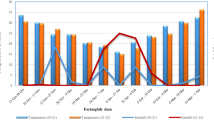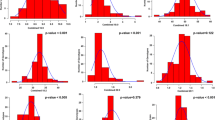Abstract
This research paper investigates the variability in seed oil content (SOC) in Indian mustard (Brassica juncea L.) under terminal heat stress (THS) conditions. A genetic stock of 488 genotypes of B. juncea was evaluated over two years and grouped into five classes based on the reduction in oil content under THS compared to normal sown crop. Based on heat susceptibility index (HSI), a diverse panel of 96 genotypes was selected and evaluated under THS. Twenty-two heat-tolerant donor genotypes were identified, including introgression lines derived from B. tournefortii, B. carinata and Erucastrum cardaminoides. This study is the first to report on marker–trait associations for SOC in B. juncea under THS using a GWAS approach. Furthermore, candidate genes associated with abiotic stress tolerance and lipid metabolism were identified near the significant SNPs, emphasizing their role in SOC regulation under stress. Notable candidate genes include BjuA003240 (encoding for alcohol-forming fatty acyl-CoA reductase), BjuA003242 (involving in lipid biosynthesis), BjuA003244 (associated with mitochondrial functions and stress tolerance), and BjuA003245 (related to MYB transcription factors regulating lipid biosynthesis). This study provides valuable insights into the genetic basis of SOC variation under THS in B. juncea, highlighting potential breeding targets for improved heat stress resilience in Indian mustard cultivation.




Similar content being viewed by others
Availability of data and materials
All data generated or analyzed during this study are provided in this published article and its supplementary data files or it will be provided upon a reasonable request.
References
Ahmad M, Waraich EA, Zulfiqar U, Ullah A, Farooq M (2021) Thiourea application improves heat tolerance in camelina (Camelina sativa L. Crantz) by modulating gas exchange, antioxidant defense and osmo-protection. Ind Crops Prod 170:113826. https://doi.org/10.1016/j.indcrop.2021.113826
Chandra A, Gupta ML, Ahuja I, Kaur G, Banga SS (2004) Intergeneric hybridization between Erucastrum cardaminoides and two diploid crop Brassica species. Theor Appl Genet 108:1620–1626. https://doi.org/10.1007/s00122-004-1592-1
Chantalat S, Courbeyrette R, Senic-Matuglia F, Jackson CL, Goud B, Peyroche A (2003) A novel Golgi membrane protein is a partner of the ARF exchange factors Gea1p and Gea2p. Mol Biol Cell 14:2357–2371. https://doi.org/10.1091/mbc.e02-10-0693
Chauhan JS, Meena ML, Saini MK, Meena DR, Singh M, Meena SS, Singh KH (2009) Heat stress effects on morpho-physiological characters of Indian mustard (Brassica juncea L.). In: 16th Australian Research Assembly on Brassicas, Ballarat Victoria, pp 91–97
Chen S, Zhang N, Zhou G, Hussain S, Ahmed S, Tian H, Wang S (2021) Knockout of the entire family of AITR genes in Arabidopsis leads to enhanced drought and salinity tolerance without fitness costs. BMC Plant Biol 21:137. https://doi.org/10.1186/s12870-021-02907-9
Cheung WY, Landry BS, Raney P, Rakow GFW (1997) Molecular mapping of seed quality traits in Brassica juncea L. Czern. and Coss. In: International Symposium Brassica, Xth Crucifer Genetics Workshop 459:139–148. Doi: https://doi.org/10.17660/ActaHortic.1998.459.15
Chien PS, Nam HG, Chen YR (2015) A salt-regulated peptide derived from the CAP superfamily protein negatively regulates salt-stress tolerance in Arabidopsis. J Exp Bot 66:5301–5313. https://doi.org/10.1093/jxb/erv263
Davey JW, Hohenlohe PA, Etter PD, Boone JQ, Catchen JM, Blaxter ML (2011) Genome-wide genetic marker discovery and genotyping using next-generation sequencing. Nat Rev Genet 12:499–510. https://doi.org/10.1038/nrg3012
Dhaliwal LK, Hundal SS, Chahal SK (2007) Agroclimatic indices of Indian mustard (Brassica juncea) under Punjab conditions. Indian J Agri Sci 77:88–91
Doyle JJ, Doyle JL, Hortoriun LB (1990) Isolation of plant DNA from fresh tissue. Focus 12:13–15
Fischer RA, Maurer R (1978) Drought resistance in spring wheat cultivars. I. Grain yield responses. Aust J Agric Res 29(5):897–912. https://doi.org/10.1071/AR9780897
Hall AE (1992) Breeding for heat tolerance. Plant Breed Rev 10:129–168
Huang SB, Van Aken O, Schwarzlander M, Belt K, Millar AH (2016) The roles of mitochondrial reactive oxygen species in cellular signaling and stress response in plants. Plant Physiol 171:1551–1559. https://doi.org/10.1104/pp.16.00166
Jiang Y, Tian E, Li R, Chen L, Meng J (2007) Genetic diversity of Brassica carinata with emphasis on the interspecific crossability with B. rapa. Plant Breed 126:487–491. https://doi.org/10.1111/j.1439-0523.2007.01393.x
Khan K, Kumar V, Niranjan A, Shanware A, Sane VA (2019) JcMYB1, a Jatropha R2R3MYB transcription factor gene, modulates lipid biosynthesis in transgenic plants. Plant Cell Physiol 60(2):462–475. https://doi.org/10.1093/pcp/pcy223
Kim JS, Jeon BW, Kim J (2021) Signaling peptides regulating abiotic stress responses in plants. Front Plant Sci 12:704490. https://doi.org/10.3389/fpls.2021.704490
Kim S, Yamaoka Y, Ono H, Kim H, Shim D, Maeshima M, Martinoia E, Cahoon EB, Nishida I, Lee Y (2013) AtABCA9 transporter supplies fatty acids for lipid synthesis to the endoplasmic reticulum. Proc Natl Acad Sci USA 110(2):773–778. https://doi.org/10.1073/pnas.1214159110
Kitagawa M, Balkunde R, Bui H, Jackson D (2019) An aminoacyl tRNA synthetase, OKI1, is required for proper shoot meristem size in Arabidopsis. Plant Cell Physiol 60(11):2597–2608. https://doi.org/10.1093/pcp/pcz153
Langmead B, Salzberg SL (2012) Fast gapped-read alignment with Bowtie 2. Nat Methods 9:357–359. https://doi.org/10.1038/nmeth.1923
Lee SB, Suh MC (2015) Cuticular wax biosynthesis is up-regulated by the MYB94 transcription factor in Arabidopsis. Plant Cell Physiol 56(1):48–60. https://doi.org/10.1093/pcp/pcu142
Li H, Handsaker B, Wysoker A, Fennell T, Ruan J, Homer N, Marth G, Abecasis G, Durbin R (2009) The sequence alignment/map format and SAMtools. Bioinformatics 25(16):2078–2079. https://doi.org/10.1093/bioinformatics/btp352
Lipka AE, Tian F, Wang Q, Peiffer J, Li M, Bradbury PJ, Gore MA, Buckler ES, Zhang Z (2012) GAPIT: genome association and prediction integrated tool. Bioinformatics 28:2397–2399. https://doi.org/10.1093/bioinformatics/bts444
Liu X, Huang M, Fan B, Buckler ES, Zhang Z (2016) Iterative usage of fixed and random effect models for powerful and efficient genome-wide association studies. PLoS Genet 12(2):1005767. https://doi.org/10.1371/journal.pgen.1005767
Mahmood T, Rahman MH, Stringam GR, Yeh F, Good AG (2006) Identification of quantitative trait loci (QTL) for oil and protein contents and their relationships with other seed quality traits in Brassica juncea. Theor Appl Genet 113(7):1211–1220. https://doi.org/10.1007/s00122-006-0376-1
Minnich RA, Sanders AC (2000) Brassica tournefortii. In: Bossard CC, Randall JM, Hoshovsky MC (ed) Invasive plants of California’s wildlands. University of California Press, Berkeley
Nagaharu U (1935) Genome analysis in Brassica with special reference to the experimental formation of B. napus and peculiar mode of fertilization. Jpn J Bot 7:389–452
Parker P (1999) The mustard industry in Australia—opportunities for a new oilseed. In: Shea G (ed) Oilseed crop updates. Agriculture Western Australia, Northam, pp 12–13
Prakash S, Bhat SR (2007) Contribution of wild crucifers in Brassica improvement: past accomplishment and future perspectives. In: Proc GCIRC 12th Int Rapeseed Congr, vol 1, pp 213–215
Prakash S, Bhat SR, Quiros CF, Kirti PB, Chopra VL (2009) Brassica and close allies: cytogenetics and evolution. Plant Breed Rev 31:56–89. https://doi.org/10.1002/9780470593783
R Core Team (2018). R: a language and environment for statistical computing. R Foundation for Statistical Computing, Vienna, Austria. https://www.R-project.org/
Rakow G, Getinet A (1997) Brassica carinata an oilseed crop for Canada. Acta Horti 459:419–428. https://doi.org/10.17660/ActaHortic.1998.459.50
Rana K, Atri C, Akhatar J, Kaur R, Goyal A, Singh MP, Kumar N, Sharma A, Sandhu PS, Kaur BMJ (2019) Detection of first marker trait associations for resistance against Sclerotinia sclerotiorum in Brassica juncea–Erucastrum cardaminoides introgression lines. Front Plant Sci 10:1015. https://doi.org/10.3389/fpls.2019.01015
Robles P, Quesada V (2017) Emerging roles of mitochondrial ribosomal proteins in plant development. Int J Mol Sci 18:2595. https://doi.org/10.3390/ijms18122595
Rout K, Yadav BG, Yadava SK, Mukhopadhyay A, Gupta V, Pental D, Pradhan AK (2018) QTL landscape for oil content in Brassica juncea: analysis in multiple bi-parental populations in high and “0” erucic background. Front Plant Sci 9:1448. https://doi.org/10.3389/fpls.2018.01448
Salisbury P (1989) Potential utilization of wild crucifer germplasm in oilseed Brassica breeding. In: Proc ARAB 7th Workshop, Toowoombu, Queensland, Australia, pp 51–53
Sandhu SK, Pal L, Rialch I, Singh M (2021) Unravelling genetic variability for moisture stress tolerance in Indian mustard and identification of high breeding value donor lines. J Environ Biol 42(6):1478–1487. https://doi.org/10.22438/jeb/42/6/MRN-1600
SAS Institute Inc. (2011) Base SAS® 9.3 procedure guide. SAS Institute Inc, Cary
Shahivand M, Drikvand RM, Gomarian M, Samiei K (2021) Key genes in the phenylpropanoids biosynthesis pathway have different expression patterns under various abiotic stresses in the Iranian red and green cultivars of sweet basil (Ocimum basilicum L.). Plant Biotechnol Rep 15(5):585–594. https://doi.org/10.1007/s11816-021-00697-y
Singh V, Bhajan C (2016) Evaluation of Indian mustard genotypes to heat stress in irrigated environment—seed yield stability and physiological model. J Crop Sci Biotechnol 19(5):333–352. https://doi.org/10.1007/s12892-016-0142-0
Srivastava JP, Balkrishn (2003) Environmental parameters influencing phenological development of mustard in relation to yield. Indian J Plant Physiol 8:349–353
Suter U, Snipes GJ (1995) Peripheral myelin protein 22: facts and hypotheses. J Neurosci Res 40(2):145–151. https://doi.org/10.1002/jnr.490400202
Trott A, Morano KA (2004) SYM1 is the stress-induced Saccharomyces cerevisiae ortholog of the mammalian kidney disease gene Mpv17 and is required for ethanol metabolism and tolerance during heat shock. Eukaryot Cell 3(3):620–631. https://doi.org/10.1128/ec.3.3.620-631.2004
Tugal HB, Pool M, Baker A (1999) Arabidopsis 22-kilodalton peroxisomal membrane protein: nucleotide sequence and biochemical characterization. Plant Physiol 120:309–320. https://doi.org/10.1104/pp.120.1.309
Wang W, Vinocur B, Altman A (2003) Plant responses to drought, salinity and extreme temperatures: towards genetic engineering for stress tolerance. Planta 218:1–14. https://doi.org/10.1007/s00425-003-1105-5
Warwick SI, Francis A, La Fleche J (2000) Guide to wild germplasm of Brassica and allied crops (tribe Brassiceae, Brassicaceae). AAFC-ECORC Contribution no. 40
Woods DL, Capcara JJ, Downey RK (1991) The potential of mustard (Brassica juncea (L.) Coss) as an edible oil crop on the Canadian Prairies. Can J of Plant Sci 71(1):195–198. https://doi.org/10.4141/cjps91-025
Xiao Z, Zhang C, Tang F et al (2019) Identification of candidate genes controlling oil content by combination of genome-wide association and transcriptome analysis in the oilseed crop Brassica napus. Biotechnol Biofuels 12:216. https://doi.org/10.1186/s13068-019-1557-x
Xing G, Li J, Li W, Lam SM, Yuan H, Shui G, Yang J (2021) AP2/ERF and R2R3-MYB family transcription factors: potential associations between temperature stress and lipid metabolism in Auxenochlorella protothecoides. Biotechnol Biofuels 14(1):1–16. https://doi.org/10.1186/s13068-021-01881-6
Yadava SK, Arumugam N, Mukhopadhyay A, Sodhi YS, Gupta V, Pental D, Pradhan AK (2012) QTL mapping of yield-associated traits in Brassica juncea: meta-analysis and epistatic interactions using two different crosses between east European and Indian gene pool lines. Theor Appl Genet 125(7):1553–1564. https://doi.org/10.1007/s00122-012-1934-3
Zhang X, Liu Y, Ayaz A, Zhao H, Lü S (2022) The plant fatty acyl reductases. Int J Mol Sci 23(24):16156. https://doi.org/10.3390/ijms232416156
Acknowledgements
The Indian mustard germplasm, used in this study, was collected/developed and maintained by ICAR National Professor Dr. SS Banga. The authors duly acknowledge the receipt of germplasm.
Author information
Authors and Affiliations
Contributions
SKS conceived and designed research. LP and JK conducted experiments. LP and DB analysed data. LP and SKS wrote the manuscript. All authors read and approved the manuscript.
Corresponding author
Ethics declarations
Conflict of interest
The authors declare that no conflict of interest exists.
Informed consent
All authors consent to participate in this manuscript.
Supplementary Information
Below is the link to the electronic supplementary material.
13205_2024_3985_MOESM1_ESM.tif
Supplementary file1: Fig. S1 SNP density plot chromosome wise representing number of SNPs within 1 Mb window size. *Chromosome 1 to 10 represents “A” genome mentioned as A01 to A10 and chromosome 11 to 18 represents “B” genome mentioned as B01 to B08 in manuscript (TIF 4563 KB)
13205_2024_3985_MOESM2_ESM.tif
Supplementary file2: Fig. S2 Genome-wide linkage disequilibrium (LD) decay plot. Linkage disequilibrium, measured as r2, between pairs of polymorphic marker loci is plotted against the physical distance (Kbp) (TIF 88 KB)
13205_2024_3985_MOESM3_ESM.tif
Supplementary file3: Fig. S3 2D plot of first two Principal Components (PCs). Red, green and yellow dots represent the distinct clusters of genotypes. Figure in parenthesis represents the explained variation by that PC (TIF 229 KB)
Rights and permissions
Springer Nature or its licensor (e.g. a society or other partner) holds exclusive rights to this article under a publishing agreement with the author(s) or other rightsholder(s); author self-archiving of the accepted manuscript version of this article is solely governed by the terms of such publishing agreement and applicable law.
About this article
Cite this article
Pal, L., Sandhu, S.K., Kaur, J. et al. Deciphering variations, identification of marker–trait associations and candidate genes for seed oil content under terminal heat stress in Indian mustard (Brassica juncea L. Czern & Coss) germplasm stock. 3 Biotech 14, 140 (2024). https://doi.org/10.1007/s13205-024-03985-w
Received:
Accepted:
Published:
DOI: https://doi.org/10.1007/s13205-024-03985-w




